beer
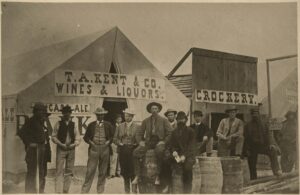 With the Westward migration in the United States, came the cowboys, and with them came the “Old West Saloons,” so that those cowboys wound have a place to wind down after a hard day’s work. We have all heard of the “Old West Cowboys” and while they were a picture of the west, it was the movies that brought them to life for most of us today. As the people moved west, many of the men came on their own at first. That brought the saloon keepers to see if they could make a buck on these men who were hungry for a little socialization. Saloons were common in almost all cities, and a few areas also had Mexican-style cantinas.
With the Westward migration in the United States, came the cowboys, and with them came the “Old West Saloons,” so that those cowboys wound have a place to wind down after a hard day’s work. We have all heard of the “Old West Cowboys” and while they were a picture of the west, it was the movies that brought them to life for most of us today. As the people moved west, many of the men came on their own at first. That brought the saloon keepers to see if they could make a buck on these men who were hungry for a little socialization. Saloons were common in almost all cities, and a few areas also had Mexican-style cantinas.
When we think of the “Old West Saloons,” we usually picture the same style. “A common wooden front with a wooden boardwalk. There were always a few hitching posts to tie a horse. Often a water source would be located close by for horses to drink. The front doors always consisted of two swinging doors that would brush up against a cowboy as he walked into the main bar area. The bar itself was very long to accommodate many standing customers. The floor area consisted of wooden tables and chairs.”
There were usually a group of men at the bar, and some at the tables playing a friendly game of poker…at least it was friendly until someone thought they were getting cheated. You put a few drinks in a guy, add to it the fact that he is losing the poker game, and it a recipe for a fight. That was how most of the violence in the towns got started…right there in the saloon and then, at times it moved out into the roadway.
We all think of the first saloons in the typical way of the movies, but that really wasn’t the case. “The first  saloons were mostly tents or square wooden structures with tent material thrown over the top. The material was enough to keep the rain off the heads of their customers. The floors were not made of wood. Tent saloons never had floors of any type. If it rained, the floors were muddy, and if it was dry, they were dusty. The only thing the early saloon offered was whiskey and a place to sit and rest.”
saloons were mostly tents or square wooden structures with tent material thrown over the top. The material was enough to keep the rain off the heads of their customers. The floors were not made of wood. Tent saloons never had floors of any type. If it rained, the floors were muddy, and if it was dry, they were dusty. The only thing the early saloon offered was whiskey and a place to sit and rest.”
The first whiskey ever served in a saloon was not the fine whiskey that we all think of. In fact, New Yorkers or those from Chicago would most likely cringe at the taste of the whiskey of the Old West. Whiskey in those days was “raw and made right in the camp or town. The simple ingredients included raw alcohol, sugar burnt, and a little pouch chewing tobacco. Whiskey with terrible names like ‘Coffin Varnish,’ ‘Tarantula Juice,’ ‘Red Eye,’ and others was common among the early saloons.” Later, when the trading with the Indians, the word “Firewater” was used to describe Whiskey. It got that name because they demonstrated its potency by pouring it over the fire. With a high enough proof, the Whiskey acted like gasoline on the fire. The name stuck, and Firewater it was!! Now, the Whisky of those days was not for the “lightweight” and was not to be sipped. The people of those days expected the patrons to drink it quickly. If they didn’t, they might find themselves “drinking a 5th of Whiskey at gunpoint.” Sipping was considered a weakness, and it was not tolerated!
Everyone thinks people of that era drank a lot of beer, but that was not common. Since pasteurization was not invented yet, the bear was warm, and if you didn’t drink it fast, it would get warmer and go flat. Whiskey kept its taste and potency no matter the temperature. “It was not until the 1880s that Adolphus Busch invented artificial refrigeration and pasteurization methods to the brewing process soon after Budweiser launched as a 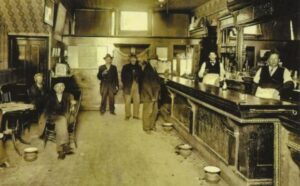 US national brand.”
US national brand.”
The first saloon was opened in the late 1820s in Bent’s Fort, Colorado. “A few little towns already had cantinas, but they did not compare to saloons that would soon spread like wildfire throughout the west. Striking gold was a big indicator that a saloon would pop up in that town. In 1848, Santa Barbara, California, only had one cantina. Yet after the discovery of gold, the town soon grew to 30 saloons. Towns like Livingston, Montana, with its 3,000 residents, had no less than 33 saloons. Back in those days, it was easy to open a business. Innovation and growth were on the incline. Saloons were profitable and with a large customer base.”
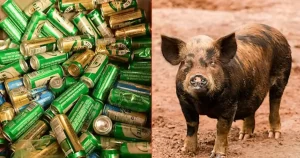 When people are camping, the first rule is to make sure trash and leftover food are stored in airtight containers and that trash is disposed of far away from the campsite. The problem with food and trash left out in a campground is that the wild animals like the smell of these things, and they tend to come into camp at night when everyone is asleep. Before long the food they first found is gone, and they are looking for the next big score. Of course, not every animal is really dangerous when they get around food or trash, but many are. It is necessary to be careful around wild animals.
When people are camping, the first rule is to make sure trash and leftover food are stored in airtight containers and that trash is disposed of far away from the campsite. The problem with food and trash left out in a campground is that the wild animals like the smell of these things, and they tend to come into camp at night when everyone is asleep. Before long the food they first found is gone, and they are looking for the next big score. Of course, not every animal is really dangerous when they get around food or trash, but many are. It is necessary to be careful around wild animals.
By the same token, it isn’t unusual for campers to have their favorite beverage in the camp…often beer. And yes, humans tend to sometimes overdo their drinking and end up making fools of themselves because they are intoxicated. Sometimes they even get themselves into heated situations…ie arguments. Some people have even been kicked out of campgrounds for their intoxicated behavior, but we aren’t the only species that has a taste for alcohol. Believe it or not, animals like to indulge too, it they can get a hold of it.
One family found this out the hard way, in Port Hedland, Western Australia. It was the middle of the night, when a commotion was heard outside of a tent in the middle of the night. The campers turned on their torches and found a feral pig tearing open their supply of beer. By the time the pig finished the beer and headed off to look for food, it had consumed 18 cans of beer. Beer pretty much having the same kind of effect on the pig as it can on humans, the pig began to feel like he was invincible, so he decided to take on with a cow that was minding its own business nearby. Unfortunately, the pig came off on the losing end of the battle, when another 
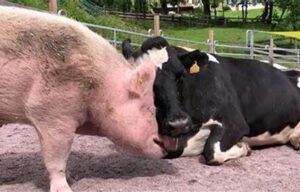 group of campers nearby, saw that the pig was being chased around their vehicle by a cow” Following the pig’s “ordeal,” the sheer amount of alcohol finally took its toll, and the pig passed out underneath a tree. Later, it was said that the police were reportedly trying to track down the pig. Apparently, the pig managed to elude the police and make its way home. What were the police planning to “charge” the pig with anyway…RUI (Running Under the Influence)??
group of campers nearby, saw that the pig was being chased around their vehicle by a cow” Following the pig’s “ordeal,” the sheer amount of alcohol finally took its toll, and the pig passed out underneath a tree. Later, it was said that the police were reportedly trying to track down the pig. Apparently, the pig managed to elude the police and make its way home. What were the police planning to “charge” the pig with anyway…RUI (Running Under the Influence)??

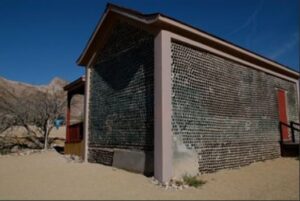 When we think of structures that have stood the test of time, we think of stone structures or structures made out of hard woods that are able to weather the elements, but sometimes a structure defies the normal expectations, as stands the test of time against all odds. There is a house in the ghost town of Rhyolite, Nevada that is the perfect example of that kind of structure.
When we think of structures that have stood the test of time, we think of stone structures or structures made out of hard woods that are able to weather the elements, but sometimes a structure defies the normal expectations, as stands the test of time against all odds. There is a house in the ghost town of Rhyolite, Nevada that is the perfect example of that kind of structure.
A local saloon owner named Tom Kelly decided to build a house in 1906. Unfortunately, lumber was scarce in the area at the time, so the innovative 76-year-old saloon owner decided to use the materials at hand to build his house…bottles. Not many people would have come up with such an idea, much less have the ability to carry out the strange design and actually make it a house. An estimated 50,000 beer, whiskey, soda, and medicine bottles were used to build the structure, and amazingly, it is still standing today. Tom Kelley was 76 years old when he built the house that took him almost six months to complete. Thankfully he didn’t have to drink all the alcohol in those 50,000 bottles. The bottle house also sports a “garden” of sculptures made of broken glass 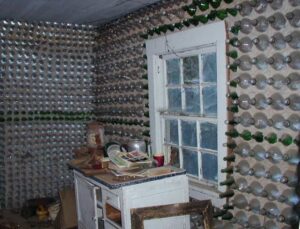 including miniature houses, bottle ropes, and a host of other “glass treasures” that would probably qualify as junk to most of us, but they seem to fit the bottle house perfectly.
including miniature houses, bottle ropes, and a host of other “glass treasures” that would probably qualify as junk to most of us, but they seem to fit the bottle house perfectly.
There was a period of time when the house was in some disrepair, but amazingly it was things like needing a new roof that caused the disrepair, not broken bottles in the structure. In 1925, Paramount Pictures wanted to use the house in a movie, so as part of the deal, they restored and re-roofed the house. The house, which really is pretty cute, was given to the Beatty Improvement Association for maintenance as a historical site. That might be part of why it still stands today, but the work that went into it originally was a big part of the house’s ability to stand the test of time.
Louis J Murphy leased and maintained the house as a museum that he ran with a woman named Bessie Stratton Moffat until he died in 1956. Later, a man named Tommy Thompson and his wife lived in the house, while maintaining a museum and a relic shop. How unique it must have been to live in such a house. No, it’s not a big house, and probably doesn’t have a monetary value that would rival today’s market, but its value really lies in a different area. The house fit the Thompsons, however. Tommy was a musician, who worked 
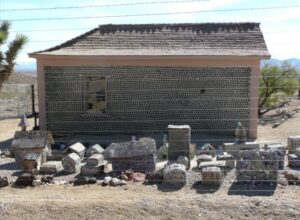 playing the accordion in the saloons in Rhyolite back when it was a boomtown. Evan Thompson maintained the house for a while after his parents died. He is the last person to actually live in the house, but he finally moved on, living in Pioneer, Nevada now. Once again, the bottle house stands empty, no longer in use, but still as resilient as ever.
playing the accordion in the saloons in Rhyolite back when it was a boomtown. Evan Thompson maintained the house for a while after his parents died. He is the last person to actually live in the house, but he finally moved on, living in Pioneer, Nevada now. Once again, the bottle house stands empty, no longer in use, but still as resilient as ever.

 Saint Patrick’s Day…a day to celebrate being Irish. For me, Saint Patrick’s Day always felt like a borrowed holiday…probably because I don’t live in Ireland. The reality is that while I don’t live in Ireland, I am part Irish…9% to be exact. With the Irish in my family history, I would have expected my percentage to be for that 9%, but the reality is that most families migrated around the world, and while a family might have been in a country for centuries, they may not have originated there. Nevertheless, I had and still have family who live in Ireland, so I guess that makes me enough Irish to make Saint Patrick’s Day as much my day as it is anyone else’s. In reality, it is a day to remember the patron saint of Ireland. Saint Patrick was a missionary who heralded the shift from paganism to Christianity in the fifth century, when he was in his 40s. Saint Patrick’s Day is celebrated on what is believed to be the anniversary of his death…March 17.
Saint Patrick’s Day…a day to celebrate being Irish. For me, Saint Patrick’s Day always felt like a borrowed holiday…probably because I don’t live in Ireland. The reality is that while I don’t live in Ireland, I am part Irish…9% to be exact. With the Irish in my family history, I would have expected my percentage to be for that 9%, but the reality is that most families migrated around the world, and while a family might have been in a country for centuries, they may not have originated there. Nevertheless, I had and still have family who live in Ireland, so I guess that makes me enough Irish to make Saint Patrick’s Day as much my day as it is anyone else’s. In reality, it is a day to remember the patron saint of Ireland. Saint Patrick was a missionary who heralded the shift from paganism to Christianity in the fifth century, when he was in his 40s. Saint Patrick’s Day is celebrated on what is believed to be the anniversary of his death…March 17.
It is traditional to wear green on Saint Patrick’s Day, but why is that? Legend has it that if you’re wearing the color green, the quintessentially Irish, fairy-like creatures called leprechauns won’t be able to see you. And if they can’t see you, they can’t pinch you. Interestingly, before Saint Patrick’s Day got started, leprechauns were known not for wearing green but red. These days, the leprechauns have begun to outsource pinching to the rest of the world, or maybe we just took it over. Even the Irish flag has green in it. It is deeply symbolic. The green represents the Irish Catholics, the orange represents the Protestants and the white represents peace between the two. The green itself is called “shamrock green.” And speaking of shamrocks, shamrocks are one of the national symbols of Ireland, and not without reason. St. Patrick himself used the green, three-leaf clover to teach the Irish about the Holy Trinity: one for the father; one for the son; and one for the Holy Spirit. The four-leaf clover is just a symbol of good luck, if you believe in luck. Personally, I prefer blessing over luck.

 When a large population of the Irish came to the United States in the mid-1800s, they wore the color green (as well as the Irish flag) as a point of national pride, further solidifying the relationship between the color green and the Irish…in the American imagination anyway. But lets face it, it’s really about the kid in all of us. Celebrating Saint Patrick’s Day with pinches and shamrock accessories might seem silly, but it can be a great way to spend a day being a little bit on the goofy side. Friendly pinches of those who are forgetful, and show up with no green, is a great way to spend that one day…often still cold and even snowy, having a little bit of silly fun. And then there is the green beer, the green Chicago river, and the green clothing, hair, and beards of our friends.
When a large population of the Irish came to the United States in the mid-1800s, they wore the color green (as well as the Irish flag) as a point of national pride, further solidifying the relationship between the color green and the Irish…in the American imagination anyway. But lets face it, it’s really about the kid in all of us. Celebrating Saint Patrick’s Day with pinches and shamrock accessories might seem silly, but it can be a great way to spend a day being a little bit on the goofy side. Friendly pinches of those who are forgetful, and show up with no green, is a great way to spend that one day…often still cold and even snowy, having a little bit of silly fun. And then there is the green beer, the green Chicago river, and the green clothing, hair, and beards of our friends.
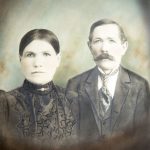 As American became populated, the immigrants brought with them, so much more than their belongings. I recently received my copy of the “Wisconsin Magazine of History” from the Wisconsin Historical Society, of which I am a member, and one of the cover stories was entitled, “German Brewing in Early Wisconsin.” Because I come from a strong German background, and was born in Wisconsin, this story was of particular interest to me. It seems that, while beer brewing in the United States began with the English, in the mid-1800s, but beer drinking was common in much of Europe, and in all levels of society, which surprised me some. We tend to expect that, higher society people would never drink beer, but the reality is that that is only in more recent years. The reality is that because on the lack of knowledge of sanitation and disease causing pathogens, many of the drinks people could make out of ordinary water really weren’t very safe to drink. Beer, on the other hand because it had to be boiled and fermented, did away with all those organisms, making it safe to drink. That made beer a very common drink by the Middle Ages. It was even given to the children.
As American became populated, the immigrants brought with them, so much more than their belongings. I recently received my copy of the “Wisconsin Magazine of History” from the Wisconsin Historical Society, of which I am a member, and one of the cover stories was entitled, “German Brewing in Early Wisconsin.” Because I come from a strong German background, and was born in Wisconsin, this story was of particular interest to me. It seems that, while beer brewing in the United States began with the English, in the mid-1800s, but beer drinking was common in much of Europe, and in all levels of society, which surprised me some. We tend to expect that, higher society people would never drink beer, but the reality is that that is only in more recent years. The reality is that because on the lack of knowledge of sanitation and disease causing pathogens, many of the drinks people could make out of ordinary water really weren’t very safe to drink. Beer, on the other hand because it had to be boiled and fermented, did away with all those organisms, making it safe to drink. That made beer a very common drink by the Middle Ages. It was even given to the children.
Upon reading this, I wondered if my German great grandparents made beer in their home. I thought about the  journal my Aunt Bertha Schumacher had written, but she never mentioned beer. I suppose it could have been because it was so common in the home, that it never occurred to her. Or could it have been because they were the exception to the rule, and didn’t really drink beer in their household. It’s hard to say, but when something is as much a cultural and traditional practice, it seems to me unlikely that they would not have done thing in the same way their families did at home. After studying German in high school, I knew that beer was talked about in many of the dialogues we learned. It just seemed to me, like it was a way to learn the words, and now a way of life, but perhaps I had been wrong on that. I suppose it could have been that because family meals in the United States, these days anyway, did not include beer, wine, or any other alcoholic drink of any kind, on a regular basis, was pretty much unheard of. It just didn’t seem like an normal activity, but in the time that my German great grandparents immigrated to the United States, drinking beer was very
journal my Aunt Bertha Schumacher had written, but she never mentioned beer. I suppose it could have been because it was so common in the home, that it never occurred to her. Or could it have been because they were the exception to the rule, and didn’t really drink beer in their household. It’s hard to say, but when something is as much a cultural and traditional practice, it seems to me unlikely that they would not have done thing in the same way their families did at home. After studying German in high school, I knew that beer was talked about in many of the dialogues we learned. It just seemed to me, like it was a way to learn the words, and now a way of life, but perhaps I had been wrong on that. I suppose it could have been that because family meals in the United States, these days anyway, did not include beer, wine, or any other alcoholic drink of any kind, on a regular basis, was pretty much unheard of. It just didn’t seem like an normal activity, but in the time that my German great grandparents immigrated to the United States, drinking beer was very 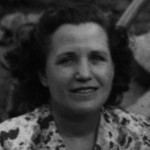 normal, so I have no reason to believe that they didn’t drink it, just like everyone else.
normal, so I have no reason to believe that they didn’t drink it, just like everyone else.
When the German immigrants arrived in America, they were required to brew their own beer. Since wheat was abundant, barley and hops easy to grow, they had no problem making their beer. I must wonder if they used whet at that time, though, because the German recipe did not include wheat, because it was needed for bread in Germany, and it wasn’t as abundant as it was in the United States. The east coast with its heat and long growing season, didn’t make a good brewing climate. When the people moved to Wisconsin, they found the climate, especially in the Milwaukee area was perfect, and I suppose the rest is history, for German beer and for Milwaukee.
 With a strong family history originating in Germany, for both my family and my husband’s family, German history has always been of interest to me. Most people know that Oktoberfest originated in Germany, but I don’t think that very many really know what Oktoberfest is all about. Everyone knows its all about a German party, and that is true, but why would there be a big party from late September to the first Sunday in October every year?
With a strong family history originating in Germany, for both my family and my husband’s family, German history has always been of interest to me. Most people know that Oktoberfest originated in Germany, but I don’t think that very many really know what Oktoberfest is all about. Everyone knows its all about a German party, and that is true, but why would there be a big party from late September to the first Sunday in October every year?
It all started with a wedding. The Bavarian Crown Prince Ludwig I, who would later become King Ludwig I of Bavaria, married Princess Therese von Sachsen-Hildburghausen. Bavaria would later become a state in Germany. The Bavarian royal family decided to make this a big event, and so they invited the citizens  of Munich to attend the festivities. The festivities were held on the fields in front of the city gates, and in honor of the new crown princess, the fields were renamed Theresienwiese, which means Therese’s fields. That being a really long name, the locals have since abbreviated it to the Wies’n. The celebration was quite grand, and concluded with horse races in the presence of the royal family. The people were so happy with this chosen couple, that the event was one filled with joy and happiness. The wedding was celebrated in varying forms across all of Bavaria. Apparently the festivities were so much fun, that the royal family decided that it needed to be an annual event, including the horse races.
of Munich to attend the festivities. The festivities were held on the fields in front of the city gates, and in honor of the new crown princess, the fields were renamed Theresienwiese, which means Therese’s fields. That being a really long name, the locals have since abbreviated it to the Wies’n. The celebration was quite grand, and concluded with horse races in the presence of the royal family. The people were so happy with this chosen couple, that the event was one filled with joy and happiness. The wedding was celebrated in varying forms across all of Bavaria. Apparently the festivities were so much fun, that the royal family decided that it needed to be an annual event, including the horse races.
The decision to repeat the festivities and the horse races in the subsequent  year gave rise to the tradition of the annual Oktoberfest, which now begins in late September and lasts until the first Sunday in October. Alcohol consumption is an important part of the modern festival, and more than 1 million gallons of beer are consumed annually at Oktoberfest. The royal wedding drew 40,000 people, probably a large amount for the time, but that paled in comparison to the 6.4 million people who celebrated the event in 1997. The horse races were eventually stopped, but held once more in 1811. Many other characteristics of the early Oktoberfest traditions have been retained in Munich to this day. So where did the name come from? Well, it is derived from Theresienwiese…or rather the shortened name, Wies’n which apparently translates…Oktoberfest.
year gave rise to the tradition of the annual Oktoberfest, which now begins in late September and lasts until the first Sunday in October. Alcohol consumption is an important part of the modern festival, and more than 1 million gallons of beer are consumed annually at Oktoberfest. The royal wedding drew 40,000 people, probably a large amount for the time, but that paled in comparison to the 6.4 million people who celebrated the event in 1997. The horse races were eventually stopped, but held once more in 1811. Many other characteristics of the early Oktoberfest traditions have been retained in Munich to this day. So where did the name come from? Well, it is derived from Theresienwiese…or rather the shortened name, Wies’n which apparently translates…Oktoberfest.
 It’s hard to think of your aunts and uncles as being young people. To you, they have always been adults, and they probably never sewed any wild oats…I mean, old people didn’t do that sort of thing did they? I suppose that the way kids sewed their wild oats in days gone by, is very different than the way kids do that today. In fact, I’m sure that wild oats in the 1940’s were really pretty tame oats in all reality. It was during this time period that my Uncle Bill, and his sisters, my Aunt Laura and my Aunt Ruth were working in the shipyards. On their few days off, they liked to get together with their friends for what Uncle Bill called a party. My dad missed out on those little gatherings, unfortunately, because he was in England fighting in World War II. but if I know him, he didn’t begrudge them their parties, because he did have R & R after all.
It’s hard to think of your aunts and uncles as being young people. To you, they have always been adults, and they probably never sewed any wild oats…I mean, old people didn’t do that sort of thing did they? I suppose that the way kids sewed their wild oats in days gone by, is very different than the way kids do that today. In fact, I’m sure that wild oats in the 1940’s were really pretty tame oats in all reality. It was during this time period that my Uncle Bill, and his sisters, my Aunt Laura and my Aunt Ruth were working in the shipyards. On their few days off, they liked to get together with their friends for what Uncle Bill called a party. My dad missed out on those little gatherings, unfortunately, because he was in England fighting in World War II. but if I know him, he didn’t begrudge them their parties, because he did have R & R after all.
Parties on those days might have meant a big gathering at one of the area lakes, somewhat like a reunion of sorts., but I seriously doubt if the gatherings they called  parties were anything like even some of the tame parties of today. If they had beer or anything like that, I would be surprised…but I could be wrong. No, I think they had picnics, went for rides on the lake in a small boat, and probably did a little fishing. What better way to relax. I do know that fishing was a part of their little outings, because Uncle Bill took a picture of the fishing.
parties were anything like even some of the tame parties of today. If they had beer or anything like that, I would be surprised…but I could be wrong. No, I think they had picnics, went for rides on the lake in a small boat, and probably did a little fishing. What better way to relax. I do know that fishing was a part of their little outings, because Uncle Bill took a picture of the fishing.
As to the wild oats, well maybe Uncle Bill did sew a few. These parties were, of course, men and women, and being a bachelor, and a definite ladies man, Uncle Bill very much enjoyed those outings, because of all the pretty girls that went along. It probably worked out very well too, if there was an equal number of men and women, but if not, well…it’s every man for himself right. So maybe they did sew some wild oats, and while their parties were quite a bit more tame than those of this century…it’s all about socializing, relationships, and fun…right.
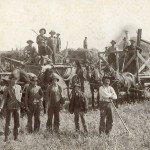 In a time where it seems like it is every man for himself, I like to look back into the family history and see how things were done back then. People in the towns banded together. If someone needed to build a barn, they had a barn raising. All the neighbors came over…and brought pot luck dinners to feed the workers. These days you have to buy your friends a case of beer and a steak dinner just to help you move! Now, I know that doesn’t apply to every situation, but think about the number of times you or someone you know couldn’t get anyone to help them move without bribing them.
In a time where it seems like it is every man for himself, I like to look back into the family history and see how things were done back then. People in the towns banded together. If someone needed to build a barn, they had a barn raising. All the neighbors came over…and brought pot luck dinners to feed the workers. These days you have to buy your friends a case of beer and a steak dinner just to help you move! Now, I know that doesn’t apply to every situation, but think about the number of times you or someone you know couldn’t get anyone to help them move without bribing them.
If we look back a few years though, we see that harvests were often brought in with the help of neighbors. They would start at one farm, and move to the next and the next, until the harvests were done. Harvesting can be a huge job, and one family really can’t harvest a big farm alone. Their neighbors had the same problem, so by working together, they could all get the job done, and everyone made a profit. Farming was and is a tough life, and when money is scarce and equipment was expensive, it was a real struggle. Many people couldn’t make it just because of weather alone, much less the inability to get the harvest in, in time to save it from the elements.
These days, so many people are struggling to make it on their own, because there is no one to help them. I don’t mean lots of government help. I mean good old fashioned elbow grease and muscle. Most people can do most things on their own, but sometimes it is easier or more fun with the help of friends and neighbors. That is how things were back then, and the best part was that it gave these neighbors who often lived miles apart, a chance to get together and enjoy each other’s company. So many people miss out on the camaraderie of friends, because they don’t allow themselves to be willing to help out a friend. It’s something we should all think about.

